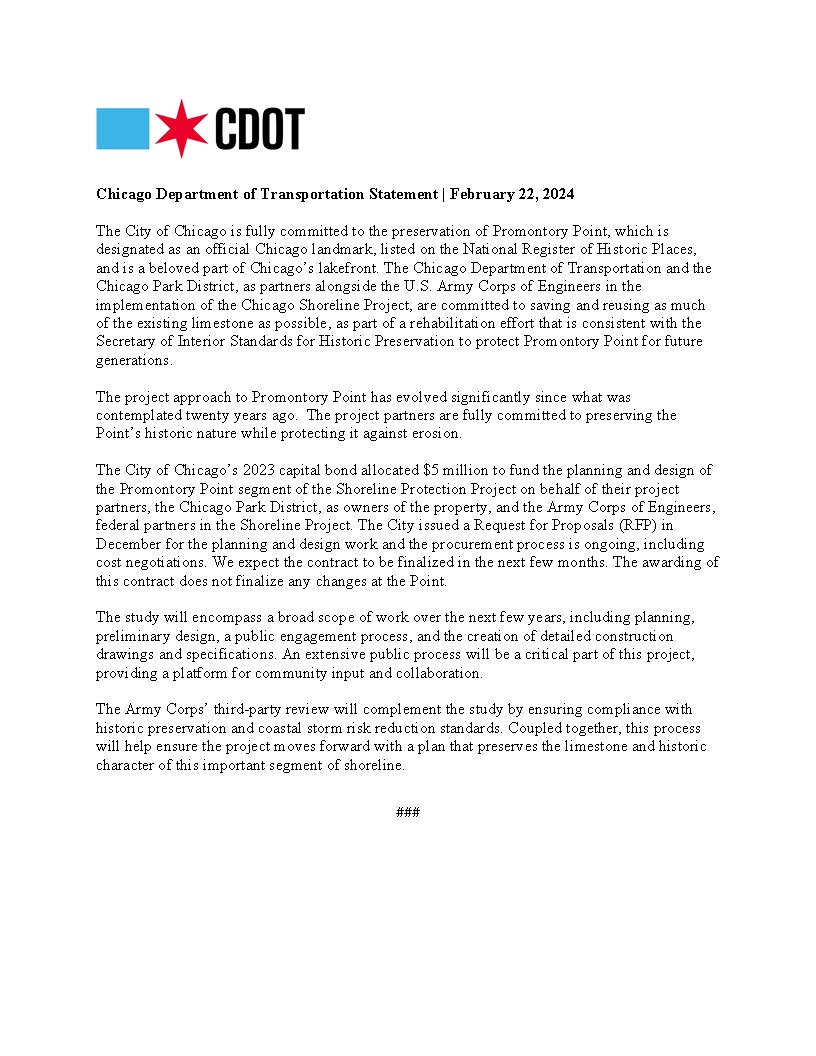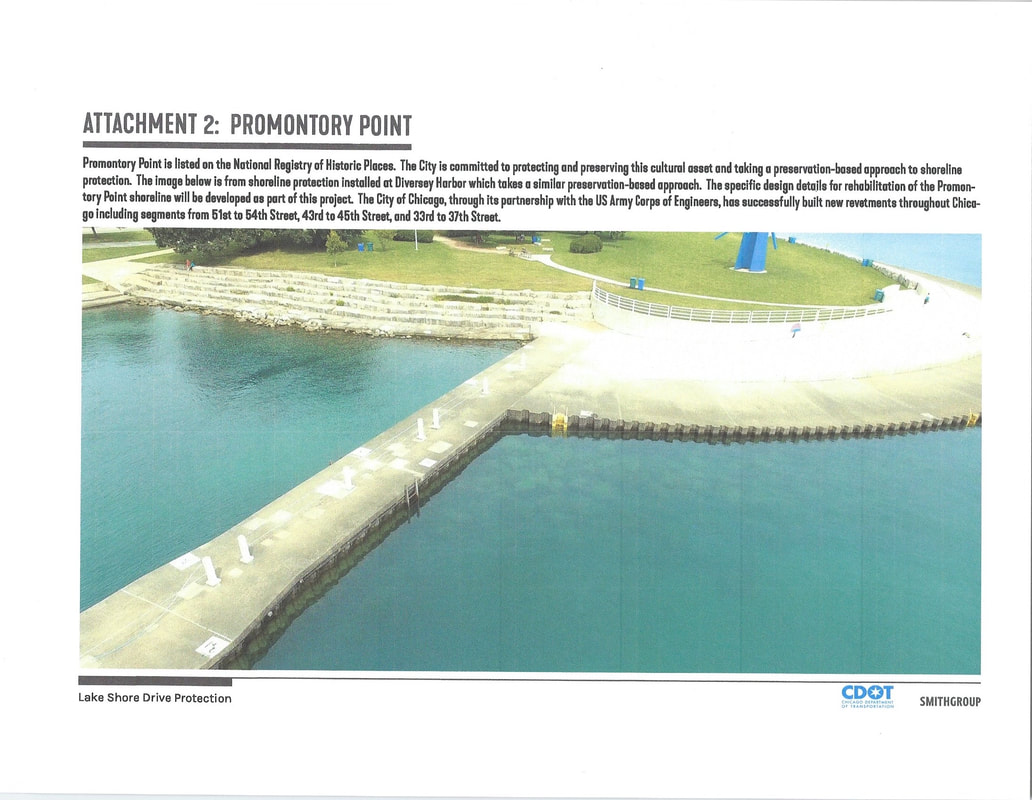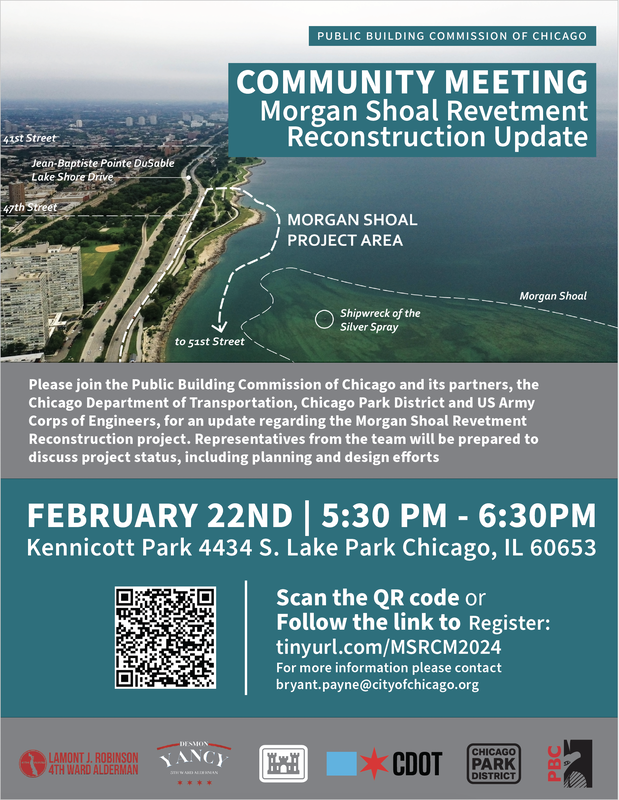Elected Officials, City of Chicago and the Community Agree: No Concrete At Promontory Point5/1/2024 FOR IMMEDIATE RELEASE April 30, 2024 Contact: Jack Spicer +1.872.226.2240 Debra Hammond +1.312.285.476 Elected Officials, City of Chicago and the Community Agree: No Concrete At Promontory Point Promontory Point Conservancy is pleased to announce that a statement from the Chicago Department of Transportation (CDOT), Chicago Parks District (CPD), and the Chicago Division of U.S. Army Corps of Engineers, addressed to 5th Ward Alderman Desmon Yancy, denies any plans to replace Promontory Point’s iconic limestone revetment and promenade with a concrete alternative. Although earlier governmental plans obtained by the Conservancy indicated otherwise, now “there is no intention of replacing the limestone with a continuous concrete revetment,” said the City on April 4, 2024. Speaking to community members on Thursday, April 4, Alderman Yancy read aloud the City’s statement, and called on the City to “listen to the community, let the community lead, and make sure Promontory Point is restored using natural limestone and not poured concrete.” The City’s statement came in response to the release of an independent Condition Study released by the Conservancy concluding that the Point’s limestone revetment is both repairable and provides more-than-adequate storm damage and shoreline protection as it is. The City did not say it has changed its previous judgement that the limestone revetment had failed, or whether it would dispute the findings of the McLaren Engineering Group concluding it has not failed. The Conservancy also notes the City’s repeated commitment to restoring the Point according to the U.S. Department of the Interior’s preservation standards, a commitment which will require the full preservation of the existing limestone, and will not be compatible with even partial concrete replacement. State Senator Robert Peters (D-13) also spoke, announcing the introduction to the Illinois legislature of a resolution to “Save the Point”. He stated that the resolution is intended to “further organizing efforts to make sure the City does the right thing,” and raise awareness for the preservation efforts outside the Hyde Park area. Friends of the Parks interim President Gin Kilgore also spoke, praising McLaren’s evaluation and credentials. “We have a legitimate study that will [help] save public funds, protect the shoreline, and maintain access.” She said. “Friends of the Parks urges our public agencies to be responsive to community priorities, and respectful of the historic spots that give Chicago character.” Other speakers included Cook County Commissioner Bill Lowry (3rd District), Landmarks Illinois’ Kendra Parzen, and Preservation Chicago Executive Director Ward Miller. For additional quotes and highlights from each speaker, please find footage available here. The Conservancy and elected officials look forward to collaboration with the City on a preservation plan to retain and repair the current limestone revetment in place. McLaren’s forthcoming Alternative Design Study Report will provide strategies, design options and cost estimates for repairing and preserving the historic revetment without replacing it with new construction. To date, this will be the only plan that meets storm damage and shoreline protection criteria AND preservation standards. The Conservancy urges the City, the Chicago Park District and the Chicago Corps to accept the elected officials’ call for community leadership and collaboration, full transparency, and legitimate preservation plans for saving the limestone revetment at Promontory Point. ### Here is the statement from CDOT that Alderman Yancy read at our April 4th press conference: "Statement for 4/4/2024" "The Chicago Department of Transportation (CDOT), the Chicago Park District, and the U.S. Army Corps of Engineers, as partners in the implementation of the Chicago Shoreline Project, look forward to reviewing the report released today. Any data and input will be valuable during the planning and design process needed to meet the goals of reducing coastal storm damage while preserving the limestone and historic nature of Promontory Point." "The project partners have publicly expressed their commitment to the preservation of Promontory Point in a manner that is consistent with the Secretary of Interior Standards for Historic Preservation. There is no intention of replacing the limestone with a continuous concrete revetment." "No planning or design work has started on the Promontory Point section of the Shoreline Protection Project. We look forward to working closely with the community, elected officials, and other stakeholders on developing a rehabilitation plan that preserves the limestone and historic character of this beloved segment of shoreline for future generations." Erica Schroeder Director of Public Information Chicago Department of Transportation office: 312-744-0707 cell: 312-520-8210
1 Comment
Promontory Point Conservancy Holds the City To Its Preservation Commitment at Promontory Point2/26/2024 FOR IMMEDIATE RELEASE
Monday, February 26, 2024 Promontory Point Conservancy Holds the City To Its Preservation Commitment at Promontory Point Promontory Point Conservancy appreciates the Chicago Department of Transportation (CDOT) and the Chicago Park District’s (CPD) public commitment to “taking a preservation-based approach” to new designs and construction at Promontory Point. A genuinely preservation-minded approach at the Point creates an easy win-win for the City of Chicago (City) and the community: the City, CPD, and U.S. Army Corps of Engineers get strong storm damage and shoreline protection, while the community continues to enjoy the limestone revetment and the lakeside park it loves so well. The Conservancy and the community will hold these agencies to their promise of creating a plan for genuine preservation. Earlier this week, CDOT issued a statement on behalf of the City about their intentions for the Point and its preservation at the behest of 5th Ward Alderman Desmon Yancy. The Conservancy applauds their commitment to genuine preservation through adhering to the rigorous legal guidelines set by the Secretary of the Interior Standards for the Treatment of Historic Properties (SOI standards). Yet, we remain vigilant on behalf of the community. The Conservancy has obtained a recent drawing by CDOT and its preferred contractor, SmithGroup, of a so-called “preservation-based approach” for the Point that, in fact, demolishes the historic limestone revetment, replaces it with concrete, and arranges non-functioning, ornamental limestone blocks in the parkland. (See attached.) This is emphatically not the legal, genuine preservation that the City now says it is committed to carrying out. CDOT and CPD’s public statements commit only to “repurposing”, “saving and reusing as much of the existing limestone as possible,” a commitment that by itself does not meet SOI standards. We are concerned that the City’s commitment goes only as far as to open up a loophole big enough for a fleet of concrete trucks. In early April, the Conservancy will be releasing its own condition study of Promontory Point conducted by McLaren Engineering Group. Already completed in draft form, this study finds that the historic limestone revetment functions right now for adequate storm damage and shoreline protection. This study shows that all but a few dozen limestone blocks can be retained and repositioned. And if repaired and maintained, the historic limestone revetment has another 86- or more years of service Although CDOT publicly states this project is “not even at square one, we’re at square zero”, CDOT has not only issued an RFP for the design study but is already negotiating a full-scope contract. CDOT has not explained why it quietly issued its RFP to prequalified firms in December by task order and selected a contractor with whom it is now negotiating a contract. CDOT had informed the Conservancy that the RFP would be posted on the City’s Procurement Services website: it is not there. They have also declined to answer for the design study’s sky-high $5 million price tag. The Chicago Corps costed a design study of Promontory Point at $450,000. The Conservancy hired its coastal engineers McLaren Engineering Group for a condition study, preservation design planning study and a cost-benefit analysis for $252,000. We applaud the City and officials’ willingness to speak on the project, but the overall lack of transparency and communication to community members is disturbing. We look forward to further dialogue and the release of McLaren’s report, which we are confident will demonstrate viable alternatives for better preserving this local landmark. For written inquiries please contact Promontory Point Conservancy at [email protected]. The City of Chicago is fully committed to the preservation of Promontory Point, which is designated as an official Chicago landmark, listed on the National Register of Historic Places, and is a beloved part of Chicago’s lakefront. The Chicago Department of Transportation and the Chicago Park District, as partners alongside the U.S. Army Corps of Engineers in the implementation of the Chicago Shoreline Project, are committed to saving and reusing as much of the existing limestone as possible, as part of a rehabilitation effort that is consistent with the Secretary of Interior Standards for Historic Preservation to protect Promontory Point for future generations.
The project approach to Promontory Point has evolved significantly since what was contemplated twenty years ago. The project partners are fully committed to preserving the Point’s historic nature while protecting it against erosion. The City of Chicago’s 2023 capital bond allocated $5 million to fund the planning and design of the Promontory Point segment of the Shoreline Protection Project on behalf of their project partners, the Chicago Park District, as owners of the property, and the Army Corps of Engineers, federal partners in the Shoreline Project. The City issued a Request for Proposals (RFP) in December for the planning and design work and the procurement process is ongoing, including cost negotiations. We expect the contract to be finalized in the next few months. The awarding of this contract does not finalize any changes at the Point. The study will encompass a broad scope of work over the next few years, including planning, preliminary design, a public engagement process, and the creation of detailed construction drawings and specifications. An extensive public process will be a critical part of this project, providing a platform for community input and collaboration. The Army Corps’ third-party review will complement the study by ensuring compliance with historic preservation and coastal storm risk reduction standards. Coupled together, this process will help ensure the project moves forward with a plan that preserves the limestone and historic character of this important segment of shoreline." — Erica Schroeder, CDOT Received from Marc Monaghan, Hyde Park Herald, [email protected] The Conservancy learned that the Chicago Dept. of Transportation (CDOT) issued its Request for Proposal (RFP) for the $5m design planning study of Promontory Point in December to prequalified firms clandestinely. We know that several highly qualified preservation architectural/engineering firms were omitted from CDOT's prequalified list. The deadline for receipt of proposals closed on January 26, and CDOT will select a contractor on February 26. We have FOIA'd for the RFP and the list of prequalified firms. We have also reached out to Alderman Yancy (5th Ward) to find out about his recent meetings with the Chicago Division of the US Army Corps of Engineers (Corps), Chicago Park District (CPD) and CDOT about this RFP and about recently announced community meetings for the construction at Morgan Shoal. (See flyer below.)
The Corps, CPD and CDOT are hosting a community meeting about the construction at Morgan Shoal on February 22, 5:30-6:30pm, Kennicott Park, 4434 South Lake Park Blvd. What CDOT and the Corps propose at Morgan Shoal will be a predictor for what they propose for Promontory Point later this year. Promontory Point and Morgan Shoal are funded for revetment reconstruction under a joint congressional funding authorization passed in December 2022. Community meetings for Promontory Point will probably begin late spring/early summer this year. Construction at Promontory Point will begin the moment construction at Morgan Shoal is completed in spring 2026. The proposed construction will close the Point for 3-5 years. The beginning of the community meetings by the governmental agencies means that it's now up to us to show up and advocate for what we want for our lakefront parks. Remember, when they ask you if you want pink or blue concrete, say "NO CONCRETE!" |
Categories
All
Archives
July 2024
AuthorDebra Hammond is currently an officer of Promontory Point Conservancy. She has always been tall for her age |


